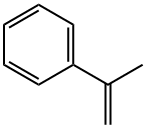α-Menthylstyrene , 99%, containing 15ppm4-olinophenylene stabilizer , 98-83-9
Synonym(s):
α-Methylstyrene;2-Phenyl-1-propene, Isopropenylbenzene;2-Phenylpropene;Isopropenylbenzene
CAS NO.:98-83-9
Empirical Formula: C9H10
Molecular Weight: 118.18
MDL number: MFCD00008859
EINECS: 202-705-0
PRODUCT Properties
| Melting point: | −24 °C(lit.) |
| Boiling point: | 165-169 °C(lit.) |
| Density | 0.909 g/mL at 25 °C(lit.) |
| vapor density | 4.1 (vs air) |
| vapor pressure | 2.1 mm Hg ( 20 °C) |
| refractive index | n |
| Flash point: | 114 °F |
| storage temp. | 2-8°C |
| solubility | 560mg/l |
| form | Liquid |
| color | Clear colorless |
| PH | 5-6 (500g/l, H2O) |
| explosive limit | 0.9-6.6%(V) |
| Water Solubility | insoluble |
| BRN | 969405 |
| Exposure limits | NIOSH REL: TWA 50 ppm (240 mg/m3), STEL 100 ppm (485 mg/m3), IDLH
700 ppm; OSHA PEL: ceiling 100 ppm; ACGIH TLV: TWA 50 ppm, STEL 100 ppm (adopted). |
| Dielectric constant | 2.2799999999999998 |
| InChIKey | XYLMUPLGERFSHI-UHFFFAOYSA-N |
| LogP | 3.48 at 25℃ |
| CAS DataBase Reference | 98-83-9(CAS DataBase Reference) |
| IARC | 2B (Vol. 101) 2013 |
| NIST Chemistry Reference | «alpha»-Methylstyrene(98-83-9) |
| EPA Substance Registry System | .alpha.-Methylstyrene (98-83-9) |
Description and Uses
Methylstyrene is a colorless liquid with a characteristic odor. Molecular weight = 118.19; Specific gravity(H2O:1) 5 0.91; Boiling point = 165.6℃; Freezing/Meltingpoint 5 2 23.3℃; Vapor pressure 5 2 mmHg at 20℃;Flash point = 54℃; Autoignition temperature 5 574℃.Explosive limits: LEL 5 1.9%; UEL 5 6.1%. HazardIdentification (based on NFPA-704 M Rating System):Health 1, Flammability 2, Reactivity 0. Insoluble in water.Potential Exposure: Tumorigen,Mutagen, Human Data; Primary Irritant. Methylstyrene isused as an additive, a plasticizer, and as a copolymer; usedin the production of modified polyester and alkyd resinformulations.
α-Methylstyrene is not a styrenic monomer in the strict sense. The methyl substitution on the side chain, rather than the aromatic ring, moderates its reactivity in polymerization. It is used as a specialty monomer in ABS resins, coatings, polyester resins, and hot-melt adhesives. As a copolymer in ABS and polystyrene, it increases the heat-distortion resistance of the product. In coatings and resins, it moderates reaction rates and improves clarity.
Safety
| Symbol(GHS) |     GHS02,GHS07,GHS08,GHS09 |
| Signal word | Danger |
| Hazard statements | H226-H304-H317-H319-H335-H361fd-H411 |
| Precautionary statements | P210-P273-P280-P301+P310-P303+P361+P353-P331 |
| Hazard Codes | Xi,N |
| Risk Statements | 10-36/37-51/53 |
| Safety Statements | 61 |
| OEB | A |
| OEL | TWA: 50 ppm (240 mg/m3), STEL: 100 ppm (485 mg/m3) |
| RIDADR | UN 2303 3/PG 3 |
| WGK Germany | 2 |
| RTECS | WL5075300 |
| Autoignition Temperature | 445 °C |
| TSCA | Yes |
| HS Code | 2902 90 00 |
| HazardClass | 3 |
| PackingGroup | III |
| Hazardous Substances Data | 98-83-9(Hazardous Substances Data) |
| Toxicity | LD50 orally in Rabbit: 4900 mg/kg |
| IDLA | 700 ppm |




